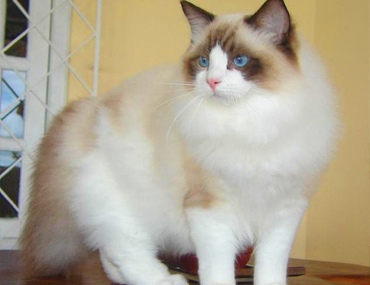History
The Ragdoll’s history began normally enough.
In the 1960s, cat breeder Ann Baker of Riverside, California developed the Ragdoll. Josephine, an Angora-type cat that was possibly feral, was bred with a Seal Point Birman. One of the male kittens produced was then bred with a Burmese, and the Ragdoll was born.
But the story gets stranger. Before Josephine was used to create the Ragdoll, she was hit by a car. After receiving treatment for her injuries at the veterinary hospital at the University of California, Baker noticed that Josephine had become docile, went limp like a rag doll when picked up, and was largely immune to pain. According to Baker, Josephine’s genes had been altered in the lab throughgenetic experiments performed by the government, and this strange claim was just the first of many to come from Baker.
 Whatever happened, today the Ragdoll is the sixth most popular cat breed in America today.
Whatever happened, today the Ragdoll is the sixth most popular cat breed in America today.
Cat Facts
Here are some interesting facts about the Ragdoll:
- Some experts argue that the Ragdoll’s gentle, floppy nature is a genetic mutation that is dangerous to the cat. In fact, some breeders in Great Britain have actually tried to breed away from that characteristic because of reports of Ragdolls approaching cars and vicious dogs and getting injured.
- The Ragdoll is a pointed cat and comes in 6 different variations: seal, chocolate, flame, blue, lilac, and cream
- Weight: 10-20 pounds
- Lifespan: 12-15 years
What are they like?
It’s true: when you pick up a Ragdoll, he’ll literally go limp in your arms!
But just because the Ragdoll is a relaxed, chilled out cat doesn’t mean that he doesn’t have a playful side. Especially when young, the Ragdoll can be a complete clown, and some Ragdolls never outgrow their inner kittens!
In reality, you’ll be hard-pressed to find a more tolerant, easygoing breed than the ragdoll. They get along with other cats, dogs, and kids as well as any pet. They’re friendly in an understated way, often gently greeting newcomers and familiar friends alike, and they’ll follow their people around the house with puppy-like curiosity.
The Ragdoll is a relatively healthy breed with just a few known health issues:
- Obesity
- Hypertrophic cardiomyopathy, a form of heart disease
- Urinary tract issues, such as bladder stones
- Hairballs, due to a long coat
Right for you?
If a Ragdoll sounds like a furry bundle of joy, you’re right! But there are always a few things to consider when welcoming a new pet into your home:
- The Ragdoll is docile and lacks the will to defend himself. He should never be let outside.
- There are lazier cats out there, but the Ragdoll is not a high-energy cat. He can be playful, but he’s mostly cuddly, malleable, and quiet.
- Grooming is easy. The Ragdoll sheds, but not heavily, and combings once or twice a week will keep the Ragdoll free of mats and tangles.
- He might be the cure for your cat allergies, as many people who are otherwise allergic to cats easily tolerate the Ragdoll.
- It takes the Ragdoll up to four years to reach full maturity, which is longer than other cats. You might have to be patient when it comes to training.
If you have any questions or concerns, you should always visit or call your veterinarian – they are your best resource to ensure the health and well-being of your pets.
